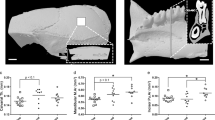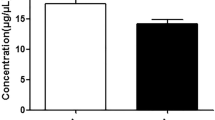Abstract
Exposure of the body to microgravity during space flight causes a series of well-documented changes in Ca2+ metabolism, yet the cellular and molecular mechanisms leading to these changes are poorly understood. Calbindins, vitamin D-dependent Ca2+ binding proteins, are believed to have a significant role in maintaining cellular Ca2+ homeostasis. In this study, we used biochemical and immunocytochemical approaches to analyze the expression of calbinding-D28k and calbindin-D9k in kidneys, small intestine, and pancreas of rats flown for 9 d aboard the space shuttle. The effects of microgravity on calbindins in rats from space were compared with synchronous Animal Enclosure Module controls, modeled weightlessness animals (tail suspension), and their controls. Exposure to microgravity resulted in a significant and sustained decrease in calbindin-D28k content in the kidney and calbinding-D9k in the small intestine of flight animals, as measured by enzyme-linked immunosorbent assay (ELISA). Modeled weightlessness animals exhibited a similar decrease in calbindins by ELISA. Immunocytochemistry (ICC) in combination with quantitative computer image analysis was used to measurein situ the expression of calbindins in the kidney and the small intestine, and the expression of insulin in pancreas. There was a large decrease of immunoreactivity in renal distal tubular cell-associated calbindin-D28k and in intestinal absorptive cell-associated calbindin-D9k of space flight and modeled weightlessness animals compared with matched controls. No consistent difference in pancreatic insulin immunoreactivity between space flight, modeled weightlessness, and controls was observed. Regression analysis of results obtained by quantitative ICC and ELISA for space flight, modeled weightlessness animals, and their controls demonstrated a significant correlation. These findings after a short-term exposure to microgravity or modeled weightlessness suggest that a decreased expression of calbindins may contribute to the disorders of Ca2+ metabolism induced by space flight.
Similar content being viewed by others
References
Arnaud, S. B., Fung, P., and Harris, B. (1991).Abstracts 8th Workshop on Vitamin D, Paris, p. 258.
Arnaud, S. B., Sherrard, D. J., Maloney, N., Whalen, R. T., and Fung, P. (1992).Aviat. Space Environ. Med. 63, 14–20.
Christakos, S., Gabrielides, C., and Rhoten, W. B. (1989).Endocr. Rev. 10, 3–16.
Dowd, D. R. (1995).Adv. Second Messenger Phosphoprotein Res. 30, 255–280.
Farach-Carson, M. C., Sergeev, I., and Norman, A. W. (1991).Endocrinology 129, 1876–1884.
Hemmingsen, C., Staun, M., Lewin, E., and Olgaard, K. (1995).Calcif. Tissue Int. 56, 372–375.
Henry, H. L. and Norman, A. W. (1984).Annu. Rev. Nutr. 4, 493–520.
Iacopino, A. M., Rhoten, W. B., and Christakos, S. (1992).Methods Neurosci. 9, 3–22.
Johnson, J. A. and Kumar, R. (1994).Curr. Opinion Nephrol. Hypertens. 3, 424–429.
Kabitskaya, O. E., Savic, Z. F., Kaplansky, A. S., Shvets, V. N., Sergeev, I. N., and Spirichev, V. B. (1984).Cosm. Biol. Aviacosm. Med. (Russian) 4, 49–55.
Lowe, K. E., Maiyar, A. C., and Norman, A. W. (1992).Crit. Rev. Eukaryotic Gene Expression 2, 65–109.
Miller, B. E. and Norman, A. W. (1983).Methods Enzymol. 102, 291–296.
Minghetti, P. P. and Norman, A. W. (1988).FASEB J. 2, 3043–3053.
Morey-Holton, E. R., Schnoes, H. K., and DeLuca, H. F. (1988).Aviat. Space Environ. Med. 59, 1038–1041.
Nemere, I. and Norman, A. W. (1991).Mol. Cell. Endocrinol. 80, C165-C169.
Norman, A. W., Roth, J., and Orci, L. (1982).Endocr. Rev. 3, 331–366.
Norman, A. W., Sergeev, I. N., Bishop, J. E., and Okamura, W. H. (1993).Cancer Res. 53, 3935–3942.
Norman, A. W., Nemere, I., Zhou, L.-X., Bishop, J. E., Lowe, K. E., Maiyar, A. C., Collius, E. D., Taoka, T., Sergeev, I., and Farach-Carson, M. C. (1992).J. Steroid Biochem. Mol. Biol. 41, 231–240.
Rhoten, W. B. (1987).Am. J. Anat. 178, 103–115.
Rhoten, W. B. and Christakos, S. (1981).Endocrinology 109, 981–983.
Rhoten, W. B. and Christakos, S. (1990).Anat. Rec. 227, 145–151.
Rhoten, W. B. and Sergeev, I. N. (1994).Endocrine 2, 989–995.
Rhoten, W. B., Bruns, M. E., and Christakos, S. (1985).Endocrinology 117, 674–683.
Sergeev, I. N. (1989).Vopr. Med. Khimii (Russian) 35, 2–11.
Sergeev, I. N. and A. W. Norman (1992).Biochem. Biophys. Res. Commun. 189, 1543–1547.
Sergeev, I. N. and Rhoten, W. B. (1995).Endocrinology 136, 2852–2861.
Sergeev, I. N. and Spirichev, V. B. (1986).Vopr. Pitaniya (Russian) 4, 50–54.
Sergeev, I. N., Blazheevich, N. V., Spirichev, V. B., and Ushakov, A. S. (1982a).Cosm. Biol. Aviacosm. Med. (Russian) 5, 74–77.
Sergeev, I. N., Blazheevich, N. V., and Spirichev, V. B. (1982b).Vopr. Med. Khimii (Russian) 28, 102–108.
Sergeev, I. N., Arkhapchev, Y. P., and Spirichev, V. B. (1983).Cosm. Biol. Aviacosm. Med. (Russian) 2, 68–73.
Sergeev, I. N., Arkhapchev, Y. P., Linberg, L. F., Blazheevich, N. V., Ushakov, A. S., and Spirichev, V. B. (1984).Biokhimiya (Russian) 49, 590–598.
Sergeev, I. N., Afonin, B. V., Blazheevich, N. V., and Morukov, B. V. (1985).Cosm. Biol. Aviakosm. Med. (Russian) 6, 46–50.
Sergeev, I. N., Blazheevich, N. V., Kaplansky, A. S., Shvets, V. N., and Spirichev, V. B. (1987).Vopr. Med. Khimii (Russian) 33, 100–107.
Spirichev, V. B. and Sergeev, I. N. (1988).World Rev. Nutr. Diet. 56, 173–216.
Ushakov, A. S., Spirichev, V. B., Belakovsky, M. S., Sergeev, I. N., and Kondratyev, Y. I. (1982).Physiologiost 25, S45-S48.
Ushakov, A. S., Sergeev, I. N., Belakovsky, M. S., Spirichev, V. B., Kaplansky, A. S., and Shvets, V. N. (1983a).Physiologist 26, S112, S113.
Ushakov, A. S., Spirichev, V. B., Sergeev, I. N., Belakovsky, M. S., and Blazheevich, N. V. (1983b).Aviat. Space Environ. Med. 54, 447–451.
Ushakov, A. S., Spirichev, V. B., Belakovsky, M. S., Sergeev, I. N., Kaplansky, A. S., and Shevts, V. N. (1984).Aviat. Space Environ. Med. 55, 534–537.
Author information
Authors and Affiliations
Corresponding author
Rights and permissions
About this article
Cite this article
Sergeev, I.N., Rhoten, W.B. & Carney, M.D. Calbindins decreased after space flight. Endocr 5, 335–340 (1996). https://doi.org/10.1007/BF02739068
Received:
Revised:
Accepted:
Issue Date:
DOI: https://doi.org/10.1007/BF02739068




